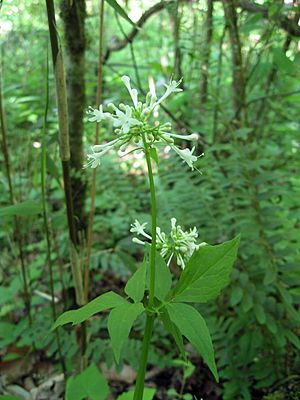Largeflower valerian facts for kids
Quick facts for kids Largeflower valerian |
|
|---|---|
 |
|
| Scientific classification | |
| Genus: |
Valeriana
|
| Species: |
pauciflora
|
Valeriana pauciflora, also known as the largeflower valerian, is a type of plant found in the Eastern United States. It belongs to the plant family called Caprifoliaceae, which includes honeysuckles. This special plant grows in specific places, often in forests with rich soil near streams or on gentle slopes.
Contents
About the Largeflower Valerian
The largeflower valerian is a perennial plant, meaning it lives for many years. It needs very healthy and specific places to grow, so you won't find it just anywhere. This plant is known for its beautiful flowers.
What Does It Look Like?
The largeflower valerian produces flowers that can be white or light pink. These pretty flowers usually bloom in the late spring and early summer.
Where Does It Grow?
This plant is native to the eastern parts of the United States. You can find it in areas like the Interior Low Plateau, which is a large region with hills and valleys. It also grows near the Ohio River and in the Potomac River Valley. It prefers forests where the soil is full of nutrients and has good moisture.
How Does It Reproduce?
The largeflower valerian has interesting ways of making new plants. It can produce seeds even without insects helping to pollinate its flowers. This is called self-pollination. However, butterflies might also visit the flowers and help move pollen, which is called cross-pollination.
What Does Its Name Mean?
The second part of its scientific name, pauciflora, comes from Latin. It means 'few-flowered'. This might seem a bit odd for a plant with pretty blooms, but it refers to a specific feature of its flower clusters.

